Pick of the Brown Bag
February 13, 2019
by
Ray Tate
The Pick of the Brown Bag returns with some decent reads that include Detective Comics, The Flash, Red Hood and The Wonder Twins. Then we have a bevy that make me happy to be a comic book reader consisting of James Bond: Origin, Outer Darkness, Spider-Gwen: Ghost Spider, Supergirl, The Titans, the Vampirella Valentine's Day Special and for pure whimsy The Unbeatable Squirrel Girl. As always should you not have the time to dig deep, the POBB is available on Twitter: #PickoftheBrownBag.
It’s really weird how quality can vary between back to back issues of comic books. You can understand how it happens with a series of novels but not issues written approximately the same time.
The last chapter of Batman depicted our heroes preventing a mass slaughter at the Flash Museum. This plot intertwined with Batman’s consuming guilt over the deaths of heroes at the Sanctuary; a tale unfolding in Heroes in Crisis. Batman helped build the Sanctuary, and he feels responsible for the murders.
That issue of Batman was a well-crafted comic book. Even had you no interest in or not yet read Heroes in Crisis there was still something to spark the mind: Batman and the Flash partnering to save lives, the Justice League prologue that was more coherent than anything currently playing out in Justice League and Guillem March’s and Tomeu Morey’s sterling artwork.
Second chapter artists Rafa Sandoval produces excellent illustration with inker Jordi Tarragona. Morey returns as colorist granting visual cohesion between the two books. I like the Flash/Batman banter and twin narration. Iris West’s reaction to Batman is a hoot.
Mind you it’s a little strange to see Iris white again. Not as jarring as white Jimmy Olsen, but still. Funny thing is that when I was researching my Jack Kirby Collections for the Female Furies review, white Jimmy Olsen didn’t bother me at all. Anyways.
The plot to the second part in the team-up is a lot to take in. It’s like a smoosh of kitchen sink comic book zaniness. Gotham Girl is keeping her dead brother alive zombie style.
The Big Bad has a castle that’s just there. How does anybody miss a castle being built or rebuilt on an island known for its drug trade mecca? Forget Batman. Wouldn't the DEA be watching for criminal activity?
So, in summary, Gotham Girl resurrected her dead brother, while hiding out in a previously unknown castle, on a criminal island.
Tom King’s Gotham and Gotham Girl appeared out of nowhere to save Batman at a critical moment. The moment appeared so pivotal that I supposed that the teens were disguised Legionnaires, and their appearance coincided with The Doomsday Clock.
I put forth the Watchmen were behind Batman’s imminent death, and the Legion time-traveled to prevent the perversion of history. That proposal would have been right up King’s alley. Unfortunately, I was wrong.
Batman saved Gotham and Gotham Girl when they were young. They felt beholden to him. They found a means to gain power to become superheroes.
Once he ascertained they were on the up and up, Batman began to train them. Writer Joshua Williamson though picks up an important detail that Batman plausibly missed.
Like Batman I thought nothing of the costumes. Perhaps, they tracked down Black Lightning's Peter Gambi. Didn’t matter. Apparently it does, and that’s impressive detective work from Williamson.
In extreme prejudice Amanda Waller, Hugo Strange and the Psycho-Pirate cut Batman’s additions to the team. They turned Gotham and Gotham Girl mad. The denouement of the episode results in Gotham’s death.
Batman found a means in theory to help Gotham Girl. He raided Bane’s island Santa Prisca to take the Psycho-Pirate into custody and used his Medusa Mask to undo the damage to Gotham Girl’s psyche.
That seemed to work. King also appeared to be writing out Gotham Girl by revealing information recapitulated here.
I’m not thrilled about Batman failing in any instance. These moments should be rare. Else, why do you need a Batman. Gotham Girl’s madness just sticks out as a retcon rather than a natural evolution. King put Batman through a grinder to obtain what the Dark Knight needed. It seems almost insulting that after all the hell Batman brought down on Bane, Gotham Girl remains crazed. I also don’t like the fact that she’s an innocent damaged forever by the Psycho-Pirate. It gives this villain too great a win. Putting that aside, the second chapter is nevertheless unbalanced by the inclusion of comic book oddities. Like clones.
Okay then. So now we have Gotham Girl holing up in a previously unknown castle with her resurrected dead brother and for reasons that escape me, a bunch of clones. Plus, it's a trap, and Venom is involved. Venom the drug, not the alien parasite pair of jeans. Admit it. Even for a comic book reader, that's a lot to swallow.
There’s never been a bad team-up between Jason Blood and Batman. Detective Comics is no different, but before we get to that, writer Peter J. Tomasi opens the story with the investigation into the deaths of Batman’s teachers. Batman interrogates another suspect Professor Hugo Strange.
The New 52 apparently wiped out the classic Detective Comics run by Steve Englehart and Marshall Rogers.
The New 52 Strange does not know Batman’s secret identity. Tomasi preserved the suspect link between Strange and Batman via his Monster Men. That said. A lot of this doesn’t make sense.
I get that Batman connects him to the monster he fought and assumes Strange learned his secret identity, but that doesn’t explain why Strange is wearing a Batman costume, a direct reference to the erased timeline. Fine. Whatever.
The New 52 Strange does not know Batman’s secret identity. Tomasi preserved the suspect link between Strange and Batman via his Monster Men. That said. A lot of this doesn’t make sense.
I get that Batman connects him to the monster he fought and assumes Strange learned his secret identity, but that doesn’t explain why Strange is wearing a Batman costume, a direct reference to the erased timeline. Fine. Whatever.
To roaring applause, Batman brings out the Hellbat from his sci-fi closet, and Tomasi elaborates on just what went into making the Hellbat. How Batman’s colleagues and friends enhanced the battle armor. Why it's so different than any old tin-can.
So the Hellbat in addition to being an allusion to Batman Beyond is essentially Ultraman’s glowing warning light fastened to his chest. Ultraman shares his life with Hayata, a Science Police Officer. When Ultraman is in danger of using too much power, thereby jeopardizing himself and Hayata, the blue light flashes red.
Batman uses the Hellbat to tackle whatever’s after the Demon. No, no. Don’t worry. This is nothing you and I have ever seen before, gentle reader.
Tomasi however makes a tenuous claim.
Wait. What? How? No. I’m not buying it. Pack it up. I’ll bet that Tomasi and Mahnke just intended for this to be a Demon/Batman team-up before the whole Countdown to 1000 began. He then did a little scrambling and shall we say adjusted the script.
In Red Hood Jason battles a weird three-headed dude named Solitary who claims to be his father.
Bizarro when brainy chatted with Solitary. Little did readers know the discussion served as foreshadowing. So good on Scott Lobdell for employing well-clever writing technique.
Solitary is the head of the Underlife. It's a spoiler. Sure, but it's not monumental. I never heard of Solitary until Red Hood and the Outlaws. So, it's not like...
..and the secret head of the Underlife is...Commissioner James Gordon. Dum-Dum-Dum.
Unfortunately, for Solitary there's no physical evidence of parenthood.
So, Jason does his best to do away with villain while freeing the captive Blockade, a youthful superhero last seen way, way back in an early volume of the Teen Titans.
Wingman, Blockade and the dog throw their lot in with Jason. Wingman unmasks and leaves readers puzzled. He's nobody apparently.
This isn't a bad issue of Red Hood it's just not as funny, surprising and/or as sweet as previous issues. I give Scott Lobdell credit for producing some unexpected links to Red Hood and the Outlaws' self-contained continuity, and a real throwback shout out to Batman Death of the Family. Also, Jason's visit to a gravesite and his admission is laugh out loud funny.
Titans once again proves to be deceptively unimportant. The gang are stuck in the Unearth, the physical creation of an innocent fantasy writer now gifted with meta human power.
The Big Bad Sister Blood captured the Green Lantern Kyle Rayner and Natasha Irons alias Steel. Blood reveals a goal worthy of the Daleks.
Sister Blood also details Raven's plight. Given the nature of the Soul-Self, it actually makes a kind of sense. All of this is good as well as the artistic moment when Miss Martian cuts loose.
The biggest surprise however is that in this issue of Titans, writer Dan Abnett divulges a key piece of information about how the Justice League might undo the whole mess involving the Source Wall. I'm sure Titans has a readership, but is it larger than say Superman, Batman or Justice League? I doubt it. Yet so many important elements that interact with the entire DCU happen in this book.
In Red Hood Jason battles a weird three-headed dude named Solitary who claims to be his father.
Bizarro when brainy chatted with Solitary. Little did readers know the discussion served as foreshadowing. So good on Scott Lobdell for employing well-clever writing technique.
Solitary is the head of the Underlife. It's a spoiler. Sure, but it's not monumental. I never heard of Solitary until Red Hood and the Outlaws. So, it's not like...
..and the secret head of the Underlife is...Commissioner James Gordon. Dum-Dum-Dum.
Unfortunately, for Solitary there's no physical evidence of parenthood.
So, Jason does his best to do away with villain while freeing the captive Blockade, a youthful superhero last seen way, way back in an early volume of the Teen Titans.
Wingman, Blockade and the dog throw their lot in with Jason. Wingman unmasks and leaves readers puzzled. He's nobody apparently.
This isn't a bad issue of Red Hood it's just not as funny, surprising and/or as sweet as previous issues. I give Scott Lobdell credit for producing some unexpected links to Red Hood and the Outlaws' self-contained continuity, and a real throwback shout out to Batman Death of the Family. Also, Jason's visit to a gravesite and his admission is laugh out loud funny.
Titans once again proves to be deceptively unimportant. The gang are stuck in the Unearth, the physical creation of an innocent fantasy writer now gifted with meta human power.
The Big Bad Sister Blood captured the Green Lantern Kyle Rayner and Natasha Irons alias Steel. Blood reveals a goal worthy of the Daleks.
Sister Blood also details Raven's plight. Given the nature of the Soul-Self, it actually makes a kind of sense. All of this is good as well as the artistic moment when Miss Martian cuts loose.
The biggest surprise however is that in this issue of Titans, writer Dan Abnett divulges a key piece of information about how the Justice League might undo the whole mess involving the Source Wall. I'm sure Titans has a readership, but is it larger than say Superman, Batman or Justice League? I doubt it. Yet so many important elements that interact with the entire DCU happen in this book.
The Wonder Twins and their space-monkey Gleek, for those not in the know, replaced original Super-Friends mascots Wendy, Marvin and Wonder-Dog just before the third Super-Friends series Challenge of the Super-Friends.
Challenge dispensed with teenage mascots altogether and pit our heroes against arch-villains assembled in The Legion of Doom. The alien siblings however would soon return in the fourth series of Super-Friends cartoons.
Challenge dispensed with teenage mascots altogether and pit our heroes against arch-villains assembled in The Legion of Doom. The alien siblings however would soon return in the fourth series of Super-Friends cartoons.
My opinion of Zan and Jayna can be summarized thusly. I don’t care. I never cared. Exception being Smallville. My opinion of Zan and Jayna in The Wonder Twins remains the same.
Justice League/Mighty Morphin Power Rangers artist Stephen Byrne is the main draw to Wonder Twins. Everything looks amazing.
Wonder Twins can be described as a hipper version of how the siblings became the teen associates of the Super-Friends.
The Super-Friends comic book by E. Nelson Bridwell and Ramona Fradon explained the trade-off previously, but not enough sex.
The introduction of the Pon Farr like Thunderlust is a real head scratcher. It doesn’t add to the plot and seems designed only to give Zan an embarrassing moment, followed by uncharacteristic sharing from Batman that makes even less sense.
Wonder Twins unlikely takes place anywhere near continuity proper. For one thing, Hawkman is part of the Justice League and Super-Friend El Dorado can be seen in cameo.
With the exception of Superman, the Justice League roster do not really act like themselves. However, this isn't exactly a Super-Friends continuity either. Black Lightning is a League member, not Black Vulcan. There's a lot of acerbic wit from Wonder Woman, and nobody but Superman knows who Mr. Mxyzptlk is.
Some of the jokes are funny. The genuine saving grace lies in the personality of the Super-Friends’ computer--the one that used to warn of a Trouble Alert--and the way the Twins put the kibosh on Mxyzptlk. Otherwise, Mark Russell’s story is mostly harmless fluff.
Oh, hey. It’s that bitch Veronica Cale from the post-Crisis.
Nope. Not even for Jesus Merino’s sweet artwork. This is what Cat Grant could have been had she not been portrayed so lovingly by Calista Flockhart.
Oh, now this is the stuff. In the last issue of Supergirl Kara ran afoul of an Omega Men villain and his latest creation Splyce.
The Big Bad and the Khunds, a DC alien race of really dumb Klingons that look like congealed lava decided to enslave Supergirl. They threw her in a cage of alien women captured from various parts of the cosmos and intended to sell her to the highest bidder.
Of course Kara was just playing possum and biding her time to stage a breakout. This was going swimmingly, with the Big Bad and Khunds becoming more embarrassed by their stupidity by the second. In the process, she ran headfirst into the Omega Men.
Supergirl is a lot of slam-bang action by visiting artist Eduardo Pansica, Julio Ferreira and Plascencia on colors. Marc Andreyko scripts an exciting plot with superb twists and fair play clues. He also entertains through rousing dialogue and narration amidst the fighting.
Enmeshed with the main plot, Krypto gets a good showing as he backs up hitchhiking archaeologist Z’ndr who faces one of the players Kara seeks.
In a standout moment, Kara demonstrates just how powerful and angry she can be. The entirety comes to a head when Kara repossess Rogol Zaar’s axe.
In a standout moment, Kara demonstrates just how powerful and angry she can be. The entirety comes to a head when Kara repossess Rogol Zaar’s axe.
Keep in mind, Supergirl is utterly tapped out of solar power. I’m fairly certain, that Kryptonians possess a storehouse of solar energy that allows them to function much in the same way we humans can last without food. Kara also evolved on a much denser planet than earth so overall, she’s stronger and tougher. But so are her opponents, uniformly unimpressed by Kryptonian survivors and ironically underestimating the House of El.
Invited to New Orleans, Vampirella takes a deep dive in killing the city's monster population. The special is nothing more and nothing less than a satisfying display of Vampirella kicking monster ass.
The art by Maria Sanapo details Vampirella's good girl/bad girl dichotomy with aplomb, and if you're worried about her team up with Gambit.
Don't be. Yes, he's cajun but not Gambit. Writer Leah Williams also makes a few jokes about the language barrier at an opportune moment.
The final act presents some witty ethical and philosophical discussion about Vampirella's history and her nature, which she uses to make a judgement call when facing a specific pack of creatures.
Really, I don't know what more you can ask for in a Valentine's Day Special. Other than a great little finale joke and a backup reprint from a rare Michael Golden Vampirella black and white.
Invited to New Orleans, Vampirella takes a deep dive in killing the city's monster population. The special is nothing more and nothing less than a satisfying display of Vampirella kicking monster ass.
The art by Maria Sanapo details Vampirella's good girl/bad girl dichotomy with aplomb, and if you're worried about her team up with Gambit.
Don't be. Yes, he's cajun but not Gambit. Writer Leah Williams also makes a few jokes about the language barrier at an opportune moment.
The final act presents some witty ethical and philosophical discussion about Vampirella's history and her nature, which she uses to make a judgement call when facing a specific pack of creatures.
Really, I don't know what more you can ask for in a Valentine's Day Special. Other than a great little finale joke and a backup reprint from a rare Michael Golden Vampirella black and white.
Ghost-Spider goes back to basics, something Spider-Gwen sorely needed. I dropped Spider-Gwen a long time ago because it drastically departed from the original ideas that attracted me in the first place. The book opens with the Mary Janes, Gwen’s band belting it out.
After an amusing confrontation with MJ, who now knows for sure her not-so-secret identity, Gwen meets up with Harry Osborne for some milkshakes and company. In this universe, Harry is a straight-up, above board kind of guy.
At the shop, Gwen talks about Spider-Geddon, which thankfully she doesn’t detail just summarizes. Writer Seanan McGuire focuses on the importance of Gwen’s part in the aftermath of Spider-Geddon. That gives her emotional weight.
Afterward, Gwen spins a web and heads for home but stops upon seeing a person in need of help. This little subplot goes into some interesting directions, and as you can see Gwen’s got her wise-cracking Spider-sense of humor back.
As well as her Dad, former Captain Stacy. Most of the time I’m opposed to superheroes revealing their secret identity to the world. In Gwen’s case it fits. The secret put too much strain on her shoulders. It’s wonderful to see Gwen happier again and devenomized. Though she still possesses a symbiotic suit.
Gwen's life isn’t perfect. She finds out that the price of fame can be steep, but it doesn’t mean a whit when you're zipping through the choreography of Takeshi Miyazawa in the midst of a hostage situation.
Gwen's life isn’t perfect. She finds out that the price of fame can be steep, but it doesn’t mean a whit when you're zipping through the choreography of Takeshi Miyazawa in the midst of a hostage situation.
This issue of Ghost-Spider is such a tonic. Can it possibly get any better? The hoods Gwen beats the tar out draw out an intriguing cliffhanger that realigns a classic Spider-Man antagonist. Gwen furthermore uses one of the nearly forgotten Spider-Powers to locate her quarry. Perfect.
Unbeatable Squirrel Girl faces Ms. Quizzler who you might think is a Riddler copy Marvel style. You’re incorrect. Ms. Quizzler is more like a walking-talking game of Jeopardy!
The Riddler is pathologically driven to leave behind a clue to his crime. So, he makes these hints as difficult as possible knowing that Batman will likely figure things out. Thereby, landing him into a deadly trap. Ms. Quizzler's very disappointed when somebody solves her riddles but believes in fair play.
Ms. Quizzler captured Peter Parker and Squirrel Girl's best friend Nancy Whitehead for fun and games. That shouldn't be a problem for your Friendly Neighborhood Spider-Man.
Ryan North nullifies Peter’s peck of powers in a particular way. So, while Squirrel Girl plays Ms. Quizzler’s games, she sends Tippy and an army of squirrels to hunt for the captives. The Avengers also show up to join team Squirrel Girl, but not in the obvious way.
The Avengers and Squirrel Girl must dope out even the identities of the hostages Ms. Quizzler abducted. Fortunately, some delightfully hilarious clues arrive in the form of Curt Connors who pays for his unwitting participation.
Ms. Quizzler’s loopy behavior which reminds me of Lucy van Pelt for some reason never fails to entertain. Perhaps, it’s guest cartoonist Naomi Franquiz’s penchant to take artistic license with some of the expressions. In addition to all these assets, the punch line to a joke setup in the introduction also signals another optimistic Squirrel Girl victory.
Ms. Quizzler’s loopy behavior which reminds me of Lucy van Pelt for some reason never fails to entertain. Perhaps, it’s guest cartoonist Naomi Franquiz’s penchant to take artistic license with some of the expressions. In addition to all these assets, the punch line to a joke setup in the introduction also signals another optimistic Squirrel Girl victory.
This is an unusual issue of James Bond because the unwavering point of view belongs to Izabel a Portuguese denizen who witnesses the events.
Parker’s creation is a riveting period character whose mastery of language and intelligence carries the story. Artist Bob Q designs her to be charming but also knowing. She may wear a beret, but Izabel is no stereotype innocent French Girl. Nor is she Mademoiselle Marie. Rather she employs cunning to stymie the Nazis in subtle ways.
So that kicks off the story. The Nazis though incensed do not haul off Izabel into a camp as they are wont to do. The Nazis haven’t conquered Portugal. It is more neutral than Switzerland. As the story progresses, Izabel notices James Bond trailing the Nazis, but she continues her “mission.”
Izabel is actually a better spy than Bond, but Bond isn’t so much a spy as a defender of the realm and protector of the world. Well, he will be. That said. Bond uses the particulars of spies to get his job done. In Origin, he comes up with a clever ruse that helps Izabel and Leipzig at a crucial point.
The Nazis seek out Leipzig because he’s privy to one of their secret weapons. Parker doesn’t go for anything outlandish. Instead, he adheres to history. The devastating secret of the Nazis is now well known and one of their tactical signatures.
Bond attempts to secure Leipzig’s passage out of Portugal, but he finds the Nazi machine a worthy foe. As a result, he must choose for the first time to save the girl or complete the operation. There’s really no choice for Bond, James Bond, and the story flows to the perfect final scene and narration that fosters Izabel’s complexity.
Outer Darkness focuses on Captain Riggs and Elox, the navigator of the Charon. This issue is less bombastic and surprising than previous issues. However, it still has merit. Writer John Layman starkly differentiates Captain Riggs from the obvious Federation antitheses.
Riggs' amusing amorality is somewhat refreshing from an outside perspective. This carries through the issue, and it's especially rewarding at a particular twist in the story.
In addition to the entertaining Riggs, there's a big reveal for Elox's exact nature, or not. He could also be as insane as one of the crew members that engages in some very immoral behavior. Makes Riggs look like a saint in comparison. Elox also divulges the secret of the universe, but he's a very unreliable narrator. Although the revelation could go either way. The truth made him insane. He knows the truth because he is sane.
Outer Darkness focuses on Captain Riggs and Elox, the navigator of the Charon. This issue is less bombastic and surprising than previous issues. However, it still has merit. Writer John Layman starkly differentiates Captain Riggs from the obvious Federation antitheses.
Riggs' amusing amorality is somewhat refreshing from an outside perspective. This carries through the issue, and it's especially rewarding at a particular twist in the story.
In addition to the entertaining Riggs, there's a big reveal for Elox's exact nature, or not. He could also be as insane as one of the crew members that engages in some very immoral behavior. Makes Riggs look like a saint in comparison. Elox also divulges the secret of the universe, but he's a very unreliable narrator. Although the revelation could go either way. The truth made him insane. He knows the truth because he is sane.





















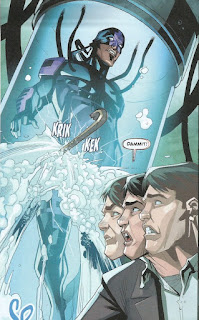



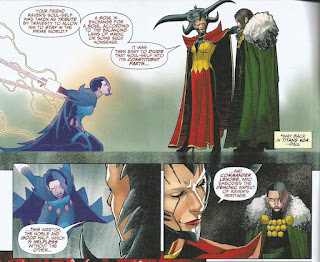







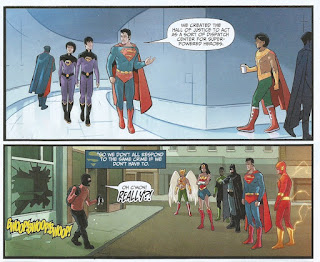











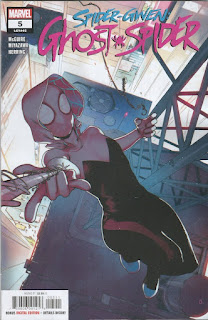





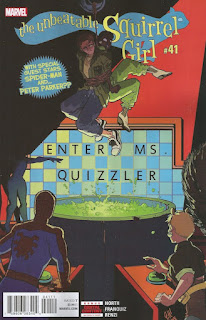










No comments:
Post a Comment